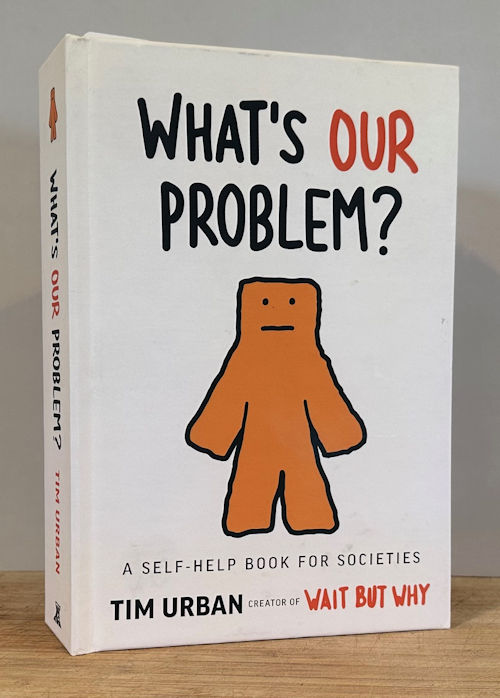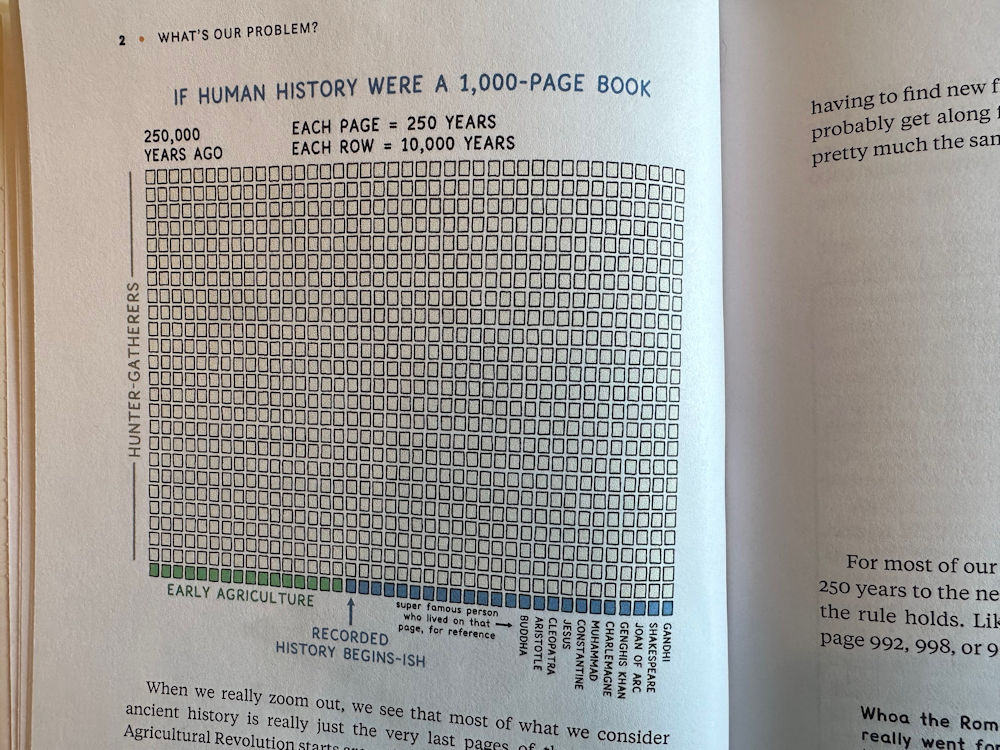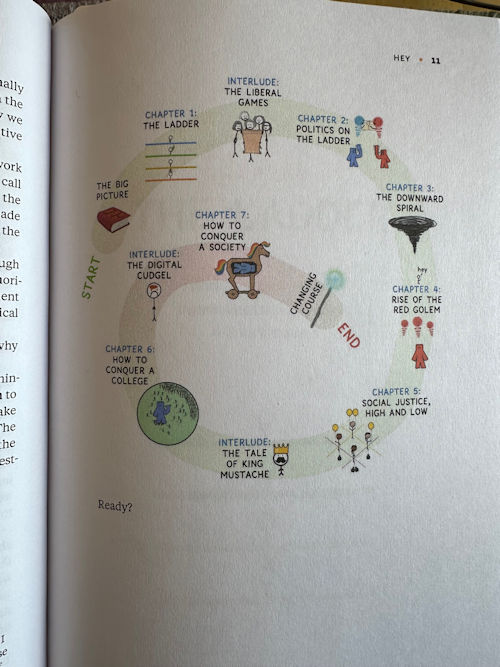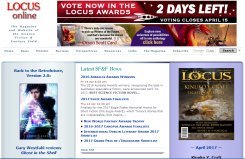(Wait But Why, 2024, 584pp, including 112pp of characters, acknowledgements, notes, bibliography, and bio)
I wrote about this book back in December, before deciding to buy it. Which I did despite some cautionary signs: it’s apparently self-published, it’s enormous, it’s expensive ($50), the only blurbs are by semi-celebrities like Lex Fridman, Andrew Yang, and Elon Musk (!). Worse, upon seeing the actual book, there’s *no index!*. Perhaps a consequence of its being self-published. (Though there are nearly 100 pages of detailed notes, keyed to the main text by page numbers.) On the other hand, he has a “long-form” blog and did a popular TED talk a while back and has some 600K followers.
Also, as I said in that previous post, the topics in the book that I could see via the Amazon preview are very similar to topics I’m interested in on this blog, if perhaps somewhat simplified and popularized, via all sorts of colorful line-drawings and cartoons.
Last month I read about the first 130 pages, then set it down for a while. There’s actually enough of substance in the book so far that I wanted to summarize the beginning before continuing on. The first hundred pages defines his terms, so to speak. And lays out his plan.
*
Introduction: The Big Picture
Beginning with this striking diagram:
In several books read recently there has been the idea of a “base” human nature, one that evolved over hundreds of thousands or even millions of years in the ancestral or Savannah environment, optimized for tribal life, in contrast to a more “advanced” or “cosmopolitan” human nature, one arguably more suitable to the global society humans have created in which once isolated tribes have become forced to deal with one another, many learning how to do so for their mutual benefit. But this can’t be quite right. The implication that some higher form of human nature has ‘evolved’ can’t be true because there hasn’t been time, over the past few thousand years, for such evolution to take place. (If I implied such a thing myself, that was an error.) More likely the situation is that there is a range of human attitudes — think Haidt and others — that amounts to built-in diversity. That range served well in the ancestral environment, given the range of different situations that occurred then. But now the environment has changed, misaligning those two ranges. And so there now many people not comfortable living in the modern environment.
Moving on. Author identifies the problem.
1, Technology is exponential. For most of history one year was like the next. Not true for the past couple ‘pages’ in our book. The last page is very different from all those before—chart, p4.
2, More technology means higher stakes. It means more good times, but also badder bad times. We’ve had world wars and now climate change. The pace of change keep dizzying.
3, My society is currently acting like a poopy-pantsed four-year-old who dropped its ice cream. It seems we’re not getting more mature; we’re getting more childish. We’re going backward in wisdom.
Ch1, The Ladder
The author identifies dueling takes on human nature, analogous to the takes by Jonathan Haidt, Daniel Kahneman, Joshua Greene, George Lakoff, and others. My paraphrases.
The PRIMITIVE MIND is “a set of coded instructions for how to be a successful animal in the animal’s nature habitat.” p14. The coder is natural selection. Occasional bugs make this software better. An animal’s software is actually optimized for the environment of its ancestors, which is OK as long as the environment changes very slowly. But humans, very quickly, have created a new environment called civilization. While our brains are optimized for our old habitat. Like moths thinking a streetlamp is the moon.
There’s also a HIGHER MIND, which can think outside itself and self-reflect and get wiser with experience. P16. It can see the world as it is, and try to behave accordingly. The primitive mind takes care of eating and sleeping, which higher mind is fine with, when it makes sense. When primitive mind takes change, you drift over into a no-sense zone. Like giving into temptation to buy a bag of candy. In the ancient world there was no processed food.
Then: the tug of war between these two minds can be represented as a four-step Ladder, p19.
- Higher mind in control
- Higher mind has the edge
- Primitive mind has the edge
- Primitive mind in control
Higher mind doesn’t mind the primitive mind having its fun, but when primitive mind is riled up, it fills the mind with smoky fog, dulling the consciousness, and higher mind. We become shortsighted and small-minded, petty, given to hypocrisy; our worst selves.
From these author developed an Idea Spectrum, a way to depict the range of opinions on a particular topic. The Higher Mind knows that humans are often delusional, and tries to learn more to become less ignorant. Primitive Mind disagrees; it’s concerned with beliefs that generate survival behavior, whether or not they’re true. And these are acquired in early life from family and community, and treat them as sacred objects. Higher Mind seeks truth; Primitive Mind seeks confirmation of existing beliefs. The four rungs on the Ladder correspond to four ways of forming beliefs.
(These are depicted with various diagrams. I’ll just summarize in words.)
Rung 1: Thinking like a scientist. You start with “I don’t know” and follow evidence wherever it takes you. You form a hypothesis: gather information, evaluate information (largely about knowing who to trust, and mastering the art of skepticism), then puzzle together a hypothesis. Express this idea publicly, and get responses. They’d welcome being wrong. (Quote from Adam Grant in Think Again). They search for the humility sweet spot between arrogance and insecurity, p28. Knowing all beliefs are subject to change by changing times or new evidence. It’s hard to do all this.
Rung 2: Thinking like a sports fan. Now you have a goal in mind, and are subject to motivated reasoning. And confirmation bias. This is Primitive Mind at work. You alternate between ‘can I believe it?’ for confirmation, and ‘must I believe it?’ when hearing dissent. You tend toward the arrogant side of conviction; it feels good to think that you are right. Once your motivation passes your interest in truth, you’re in ‘Unconvinceable Land’ where people can’t be persuaded by any amount of evidence. Religion, ideology, dogma.
Rung 3: Thinking like an attorney. It’s their job to win, and nothing can alter their allegiance. You don’t start at point A, you start at B, knowing your conclusion. In the real world a courtroom hosts both sides of a case, not just one. Attorneys will never admit a point and consider that they’re wrong.
Rung 4, Thinking like a zealot. Their sacred ideas are precious babies to be adored and protected. Challenges to their beliefs are taken as personal insults. The is the Primitive Mind on overdrive. Zealots live in simple, crisp, black and white worlds.
These four can be grouped into high-rung thinking and low-rung thinking. Each of us is a mix.
\
That’s only through page 37. What I like about the book is that he starts with basic principles — his primitive mind and higher mind — and extrapolates them into a range of behaviors of people. A bit like building up a geometry from postulates.
Further topics in this long book include “liberal games” (that is building systems of rules to manage primitive impulses, like the US Constitution was intended to do), the downward spiral of tribalism, the rise of the golem (i.e. the Republican party since the 60s), social justice, colleges, society, and ideas about how to change course. Here’s the author’s diagram of the book:








